I don’t remember the first time I encountered a wild turtle as a kid. Where I grew up in suburban Somerset County, the yards were mostly fenced in and fairly well kept. The closest “natural” land to me was a park down the street that backed up to the Green Brook, and off in the other direction was a degenerate patch of woods that sat behind a driving range off Route 22 where friends and I would go hunt for errant golf balls. The older kids would say that water moccasins would attack you if you got too close to the swampy area near the brook. It probably took me another ten years to learn that water moccasins, or cottonmouths, don’t range this far north along the east coast, and what the locals were really seeing were northern water snakes; an animated, but harmless serpent. Probably, like so many kids growing up in the country’s most densely populated state, the first live turtle I ever saw was likely in a zoo.
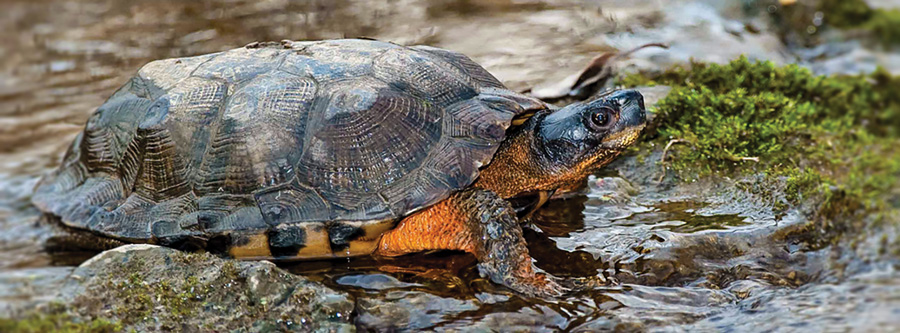
I do, however, have a vivid memory of my first wood turtle. It was spring of 2003, and I was standing atop a bridge with my boss at the time, getting ready to head down to the Wallkill River to begin a survey for New Jersey Division of Fish and Wildlife’s Endangered and Nongame Species Program, my current employer. There he was, a male cruising downstream through the center of the water with orange neck stretched out straight ahead of him, seemingly eager to get where he was going. Spring and fall are breeding times for wood turtles, and this guy may have well been searching out a mate.
Maybe four years later, I received a phone call from a homeowner who said she had found a wood turtle in her yard and she had it in a Tupperware bin. She was calling from North Plainfield, and her backyard abutted the Green Brook floodplain, just about ten miles upstream from the park near my home as a child. Knowing the area well, and by that time having studied wood turtles for several years in some of the most pristine habitat left in the state, I was hesitant to believe that the caller’s identification was correct. Or perhaps we were talking about someone’s escaped pet. Photos were shared over email and, sure as the day is long, it was a wood turtle. I reviewed our state database of known observations, and there had been some recorded in the general area in the mid-90s. We arranged a visit, attached a radio-transmitter to the turtle, released it back into the Green Brook, and then monitored the turtle’s movements for the next two months. If this had been a pet, or a turtle unfamiliar to the area, we would have expected to see long, linear movements as he tried to orient itself upon release. But this old male quickly fell into a routine, and we felt confident that he’d just wandered up from the stream to the backyard as part of what may have been a decades-long tradition. As he settled into his overwintering spot in late November, in a deep pool along the stream, aside what I recall as a discarded shopping cart (or was it a rusty bicycle?), I felt proud to have met this lone male. He grew up here, surviving for what may have been more than thirty years all the various threats that come with suburban territory: new construction, a curious dog, a SUV’s tire, a lawn mower. If someone had seen him, it was his good fortune that he had not been taken home for the kids to play with, where he would have likely succumbed to poor husbandry. He was a relic of a time past when the Green Brook was bounded by agricultural lands, an environment where wood turtles flourished. We removed his transmitter that same year, and I have not been back since, but he’s a reminder to me of how important it is to protect and strategically manage the remaining natural lands we have in New Jersey so we can avoid inadvertently creating these isolated islands of habitat where stranded wildlife barely cling on.
The wood turtle is a resident species, and we do our best to manage their and other wildlife populations amongst a landscape of development, trying to secure and restore viability for animals that often need more than what we’ve left remaining for them. For the last couple of years our team at NJDEP, along with a number of conservation partners, has been working to develop the Connecting Habitat Across New Jersey (CHANJ) project. A bobcat can travel over ten miles in a day, while the wood turtle may cover that distance in over a week; and it may take a spotted salamander a number of years. But the fact is that all of our terrestrial wildlife, from turtles to black bears, requires space to roam to do all the things creatures need to do—eat, breed, escape, shelter—and the fragmented patches of natural lands we have left are often too small in size to support those needs. We are literally at a “cross-roads” in determining how to maintain healthy ecosystems in our state, and it’s our job to provide these animals safe passage through what can be a perilous maze of housing, parking lots, and busy roadways.

Our friend the turtle, and all walking wildlife, stands to benefit from the executed actions directed by CHANJ. A map of critter habitat cores and the potential dispersal corridors between them will highlight areas where we need to take strategic action that includes more land protection and restoration, and wildlife passage projects to allow animals to safely move across roadways. All of our turtles share common threats and dangers when trying to move through fragmented places. The armor that is their shell, top and bottom, has protected them for over two-hundred million years, through the reign of the dinosaurs, surviving comets, earthquakes, volcanoes, and whatever else the Universe could throw at them. The Lenape believed the Earth was placed on a turtle’s back, and Aesop’s Fables taught us that slow and steady could win a race. For all that endurance and perseverance, evolution becomes moot versus the tire of my 2002 Honda Civic or the blade of my riding mower. Now, I don’t think that we’ll be the last generation to enjoy wild turtles, but opportunities are here now to perhaps stem the decline that is the prevailing trend for these ancient reptiles.
Each of us, from the career conservationist to the concerned citizen, can play a role in helping turtles live out their long lives. (Some of them can be over fifty years old!) Move turtles off the roadway several feet off the shoulder in the direction they were heading. Please don’t bring them to another place you feel they’ll be safer. Turtles are imprinted on the home turf and don’t do well when relocated to unfamiliar terrain. One study found that a displaced wood turtle moved over one mile trying to find his way back home, a distance over which many dangers exist. If an alien life form picked you up while crossing a street and dropped you in Lebanon, Kansas you’d be a bit out of sorts! Injured turtles can and should be transported to one of the state’s licensed wildlife rehabilitators.
Why is the turtle risking life and shell to cross the road in the first place? If it’s late May or June it may be a female trying to find a place to lay her eggs. Wood turtles lay about ten eggs per clutch just once per year. Open areas that receive plenty of sunlight are preferred nest sites, and suburban turtles frequently end up in lawns, flowerbeds, and mulch piles to make their deposits. Be it snapping turtle or eastern box turtle, there is no parental care of the eggs, which are vulnerable as they incubate beneath the soil. Neighborhood predators like raccoons or opossums can sniff out fresh nests and quickly consume that next generation of tiny turtles.
If you see a turtle nesting in your yard, consider letting it finish its business and leave the area before erecting a small fence—perhaps made from chicken wire—extending a foot or two in diameter around the nest hole. Marking the zone can deter the nest from being disturbed by foe or forgetful friend before the eggs have had a chance to hatch in mid-August through September. As July turns to August it can be a safer play to remove the fencing as not to entrap any emerging hatchling turtles later that month. A shiny new wood turtle is just slightly larger than a half-dollar out of the egg—they need all the help they can get!

A long-lived species, adult female wood turtles are critically important to the local population, and providing them passage and access to nesting areas and giving their young a chance to hatch and grow themselves into adults is of paramount consequence. Because it takes up to ten years for a hatchling turtle to reach adulthood, it could be decades before the death of a breeding age female is offset. And little turtles often have little luck at surviving their first couple of seasons, with perhaps no better than a 50% chance. Kermit the Frog may have said it, but the sentiment resonates here, too – “It isn’t easy being green.”
Whether it’s planting strawberries in your yard for turtles to eat, lifting your fences enough for a turtle to squeeze under, creating a nesting area in your lawn designated as “Turtle Parking Only,” or supporting efforts to build “turtle tunnels” under a road, there is a progressive movement here in New Jersey to be better stewards of our private and public lands and to take what measures we can to reverse the trend of habitat loss and degradation that has accounted for the imperilment of much of our native wildlife that at one time was considered common.
I have a more recent memory of finding wood turtles along a stretch of river in Sussex County just this past April. Our group found eight that day, including three pairs mating in the water. We were along a good stretch of riparian corridor where we’ve spent several seasons monitoring the population and our survey results here were in line with what you’d expect in a habitat area this intact. Ignoring the sounds of passing trucks on the nearby state road and just focusing on the visuals, you’d think you were in some remote patch of wilderness. Initiatives like CHANJ focus conservation efforts on maintaining and improving places like this so these wood turtles get what they need now, and what they’ll need thirty years from now. It’s ambitious to sometimes think so far ahead when the present demands so much attention, but I’d prefer to show my six-month old son his first wood turtle out in the woods so his first turtle memory doesn’t involve a man-made bridge or a zoo.
Ten species of freshwater turtles are commonly found in northern New Jersey, including two non-native species introduced to our waters over several decades. Four of those species carry a conservation status of endangered, threatened, or special concern: bog turtle (Federal Threatened, State Endangered), wood turtle (State Threatened), spotted turtle (Special Concern), and eastern box turtle (Special Concern). Just these four turtles account for over two hundred “on road” observations reported to us, and if we included our other six species, it would be in the thousands. We’d encourage you to submit your sightings of these most imperiled turtles to N.J. Division of Fish and Wildlife using the form found here.
Turtles are typically active from March through November and nest on land between mid-May and early July. Major threats to the health of our turtle populations are loss of habitat, road mortality, and illegal collection. There are no turtle species in the state that can be taken from the wild as pets, and it is illegal to release captive or pet turtles into the wild. If you find a turtle in trouble check here for a list of wildlife rehabiliators
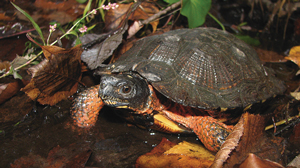
Wood turtles, which range from 8 to 9 inches, inhabit slow moving streams where the surrounding landscape includes wetlands and upland habitat.
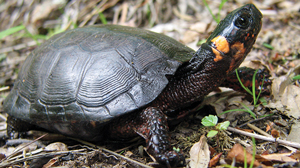
Bog turtles like groundwater-fed wetlands including but not limited to fens and wet meadows. They are the smallest of our local turtles, only about 4 to 5 inches, with a dark shell and an orange patch on their neck.
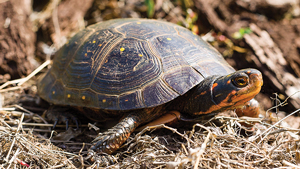
Spotted turtles prefer shallow wetland habitats including but not limited to cattail marshes and small vernal pools. Their shell is dark with yellow spots; adult females average 5.6 inches and males 4.8 inches.
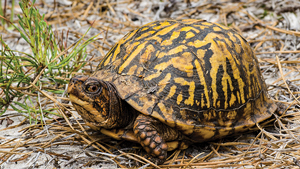
You’ll usually find box turtles in terrestrial habitats or in shallow pools on a hot day. Their domed shell pattern and color is highly variable. Box turtles have a hinged lower shell and average 8 to 9 inches.
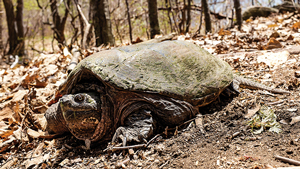
The largest freshwater turtle inhabits slow-moving, permanent, fresh waterbodies with muddy bottoms. Male snappers average about 20 inches long.
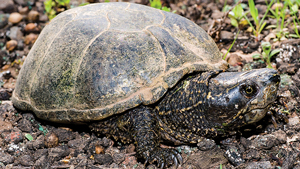
Also called “Stinkpot”, musk turtles are 5 to 6 inches long, with a hinged lower shell. They like slow-moving bodies of water with soft bottoms, including but not limited to rivers, streams, lakes, ponds and swamps.
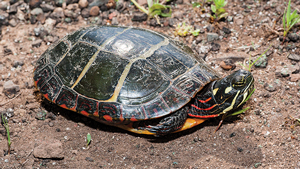
Painted turtles are frequently seen basking on slow-moving, waterbodies with abundant vegetation. Adult females which average ten inches long are much larger than the males (6 inches).
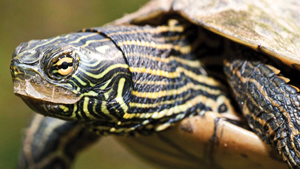
Delaware River and portions of Raritan River and associated canals of each river are home to the northern map turtle. Adult females average 10.7 inches and males 6.3 inches.
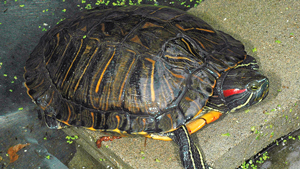
Sliders are a popular pet turtle that is often released into the wild and found in lakes, swamps and slow moving rivers. They range from 9 to 12 inches. (Photo: Jonathan Mays)
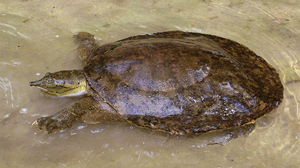
Favoring river habiat, the spiny softshell has leathery-appearing shell and a long, narrow snout. Adult females average 21.3 inches and males 8.5 inches. (Photo: Jonathan Mays)
For NJ Division of Fish and Wildlife's Field Guide to Reptiles and Amphibians (pdf), click here.